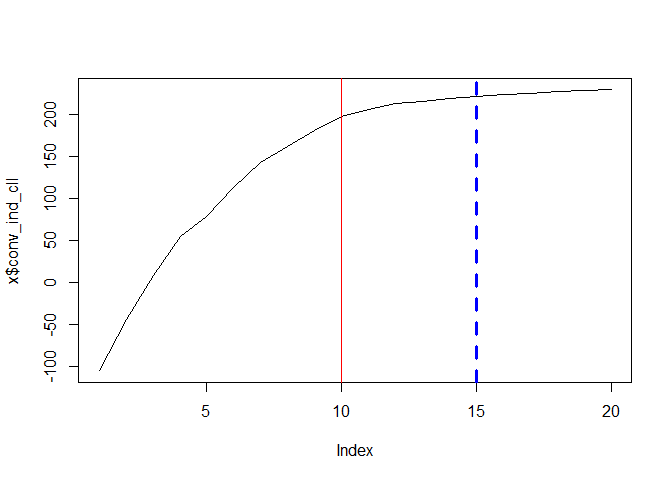
The goal of winputall is to provide cost input per crop. Using a time-varying random parameters model developed in Koutchade et al., (2024) https://hal.science/hal-04318163, this package allows allocating variable input costs among crops produced by farmers based on panel data including information on input expenditure aggregated at the farm level and acreage shares. It also considers in fairly way the weighting data and can allow integrating time-varying and time-constant control variables.
You can install the development version of winputall like so:
devtools::install_gitlab("obafemi-philippe.koutchade/winputalloc", host = "https://forgemia.inra.fr")This is a basic example which shows you how to estimate the population’s parameters and calibrate the input uses per crop:
library("winputall")
data(my_winputall_data)
fit <- rpinpallEst(data = my_winputall_data,
id_time = c("id","year"),
total_input = "tx",
crop_acreage = c("s_crop1","s_crop2","s_crop3"),
distrib_method = "lognormal",
sim_method = "map_imh",
calib_method = "cmode",
saem_control = list(nb_SA = 10, nb_smooth = 10, estim_rdraw = 100))
#> | | | 0% | |== | 3% | |===== | 7% | |======= | 10% | |========= | 13% | |============ | 17% | |============== | 20% | |================ | 23% | |=================== | 27% | |===================== | 30% | |======================= | 33% | |========================== | 37% | |============================ | 40% | |============================== | 43% | |================================= | 47% | |=================================== | 50% | |===================================== | 53% | |======================================== | 57% | |========================================== | 60% | |============================================ | 63% | |=============================================== | 67% | |================================================= | 70% | |=================================================== | 73% | |====================================================== | 77% | |======================================================== | 80% | |========================================================== | 83% | |============================================================= | 87% | |=============================================================== | 90% | |================================================================= | 93% | |==================================================================== | 97% | |======================================================================| 100%You can get the summary of estimations (estimated population’s parameters and corresponding standard errors and p-value ) using this command:
summary(fit)
#> $beta_b
#> Estimate StdErr t_value
#> Crop_1 0.7772689 0.06570165 11.830279
#> Crop_2 0.5297797 0.09782499 5.415586
#> Crop_3 1.2169040 0.07436374 16.364212
#>
#> $diag_omega_b
#> Estimate StdErr t_value
#> Crop_1 0.04603818 0.03148300 1.4623186
#> Crop_2 0.02615730 0.05356099 0.4883647
#> Crop_3 0.01296759 0.02344922 0.5530073
#>
#> $diag_omega_e
#> Estimate StdErr t_value
#> Crop_1 0.01615169 0.007719528 2.092316
#> Crop_2 0.03173457 0.022924172 1.384328
#> Crop_3 0.02160216 0.018489916 1.168321
#>
#> $omega_u
#> Estimate StdErr t_value
#> omega 0.03170063 0.008060302 3.932934
#>
#> $beta_d
#> Estimate StdErr t_value
#> fid_time21994 -0.13215383 0.09445111 -1.39917707
#> fid_time21995 0.08932896 0.18016078 0.49582911
#> fid_time21996 0.04496308 0.17628944 0.25505262
#> fid_time21997 0.12736342 0.13923467 0.91473922
#> fid_time21998 0.17879365 0.15565737 1.14863594
#> fid_time21999 0.05106855 0.21358304 0.23910396
#> fid_time21994 -0.03070283 0.33257419 -0.09231875
#> fid_time21995 -0.07691945 0.28160530 -0.27314631
#> fid_time21996 0.10653954 0.35942967 0.29641274
#> fid_time21997 0.05947997 0.19357462 0.30727150
#> fid_time21998 0.19368997 0.33609837 0.57628954
#> fid_time21999 0.03223149 0.34468248 0.09351068
#> fid_time21994 -0.06017281 0.15470565 -0.38895031
#> fid_time21995 -0.01287218 0.22154472 -0.05810194
#> fid_time21996 0.08400325 0.24947392 0.33672157
#> fid_time21997 0.06573556 0.18051578 0.36415406
#> fid_time21998 0.16581007 0.33843364 0.48993378
#> fid_time21999 0.25704377 0.13631188 1.88570341
#>
#> $sim_r_squared
#> Estimate
#> sim_r2 0.9714626To check the convergence, run for example:

The following code shows you the distribution of crop input uses:
print(fit)
#> Call:
#> rpinpallEst(data = my_winputall_data, id_time = c("id", "year"),
#> total_input = "tx", crop_acreage = c("s_crop1", "s_crop2",
#> "s_crop3"), distrib_method = "lognormal", sim_method = "map_imh",
#> calib_method = "cmode", saem_control = list(nb_SA = 10, nb_smooth = 10,
#> estim_rdraw = 100))
#>
#> Distribution of crop input uses:
#> s_crop1_sh_X s_crop2_sh_X s_crop3_sh_X
#> Mean 2.3927492 1.8060243 3.6452724
#> Std.dev. 0.5446767 0.2543858 0.4654085
#> Min. 1.3568567 1.3006835 2.8313031
#> 1st Qu 1.9947475 1.6210932 3.3103693
#> Median 2.3124879 1.7635334 3.5749411
#> 3rd Qu 2.7370671 1.9608913 3.9342869
#> Max. 4.3532843 2.5381585 5.8771426
#>
#> Mean by year of crop input uses:
#> year s_crop1_sh_X s_crop2_sh_X s_crop3_sh_X
#> 1 1993 2.227616 1.702107 3.274500
#> 2 1994 1.989743 1.693060 3.183226
#> 3 1995 2.481038 1.585247 3.334575
#> 4 1996 2.367732 1.934447 3.686225
#> 5 1997 2.588016 1.835067 3.617081
#> 6 1998 2.704236 2.105305 3.998485
#> 7 1999 2.390864 1.786936 4.422814The following code shows the first parts of the estimated crops’ input uses:
library("Matrix")
head(fit$xit_pred)
#> id year s_crop1_sh_X s_crop2_sh_X s_crop3_sh_X
#> 1 1 1993 2.356701 1.699979 3.160915
#> 2 1 1994 1.956179 1.587084 2.831303
#> 3 1 1995 2.496381 1.549041 3.070641
#> 4 1 1996 2.632345 1.950286 3.556513
#> 5 1 1997 2.854353 1.833753 3.510459
#> 6 1 1998 2.953382 2.092654 3.853185